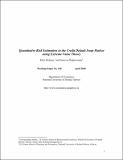| dc.contributor.author | Moloney, Kitty | en |
| dc.contributor.author | Raghavendra, Srinivas | en |
| dc.date.accessioned | 2010-11-26T16:20:53Z | en |
| dc.date.available | 2010-11-26T16:20:53Z | en |
| dc.date.issued | 2010 | en |
| dc.identifier.citation | Moloney, K.& Raghavendra, S. (2010) Quantitative Risk Estimation in the Credit Default Swap Market using Exteme Value Theory (Working Paper No. 0158) Department of Economics, National University of Ireland, Galway. | en |
| dc.identifier.uri | http://hdl.handle.net/10379/1464 | en |
| dc.description.abstract | This paper is motivated by empirical evidence illustrating the non-Gaussian nature of financial returns, (Jondeau et al 2007) and analyses extreme value theory, (EVT) as a proposed improvement (Embrechts et al., 2005) for risk estimation techniques.
Credit default swaps, (CDS¿s) are analysed due to their increasing important to financial stability (European Union, 2009) and due to the lack of quantitative univariate risk analysis of this market. EVT is generally applied to currency, equity and bond markets, (Assaf, 2009). Whereas the majority of quantitative analysis of the CDS market has focused on multivariate functions, analysing the dependency of CDS market returns and other asset returns, (Chen et al., 2008). Equity and bond samples are used here as a comparison to the CDS market returns.
The findings are divided into three parts. The first part focuses on the general characteristics of the three asset classes, CDS¿s, equities and bonds, noting the non-normality of the distributions. As GARCH is widely used in industry to remove dependency in the second and higher moments, the second part of the findings assesses the efficacy of this methodology. Evidence that GARCH removes dependency in the second moment is found but the distribution of the residuals continues to appear non-Gaussian for all three asset classes and non-iid for the CDS sample. In light of these findings, the third section uses a semi parametric approach to estimate the tail parameter of the distribution of the three CDS samples. The result of the investigation suggests that the parametric GARCH-EVT approach may be suitable for equity and bond market univariate risk estimation but that this approach and the semi-parametric EVT approach may both have limitations in assessing risk in CDS market returns. | en |
| dc.format | application/pdf | en |
| dc.language.iso | en | en |
| dc.publisher | National University of Ireland, Galway | en |
| dc.relation.ispartofseries | Working paper;0158 | en |
| dc.rights | Attribution-NonCommercial-NoDerivs 3.0 Ireland | |
| dc.rights.uri | https://creativecommons.org/licenses/by-nc-nd/3.0/ie/ | |
| dc.subject | Economics | en |
| dc.title | Quantitative Risk Estimation in the Credit Default Swap Market using Exteme Value Theory | en |
| dc.type | Working Paper | en |
| dc.description.peer-reviewed | peer-reviewed | en |
| nui.item.downloads | 1018 | |


